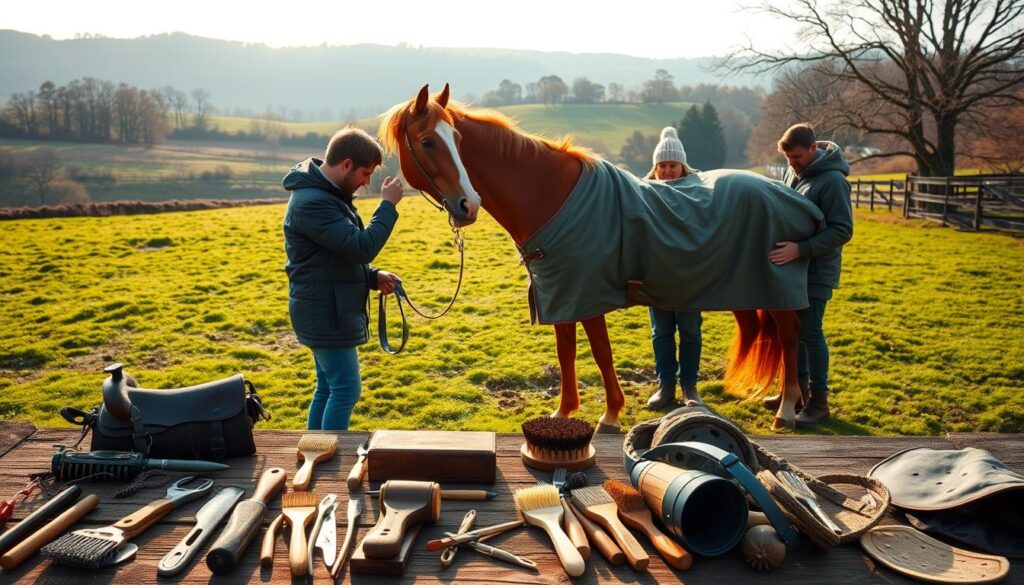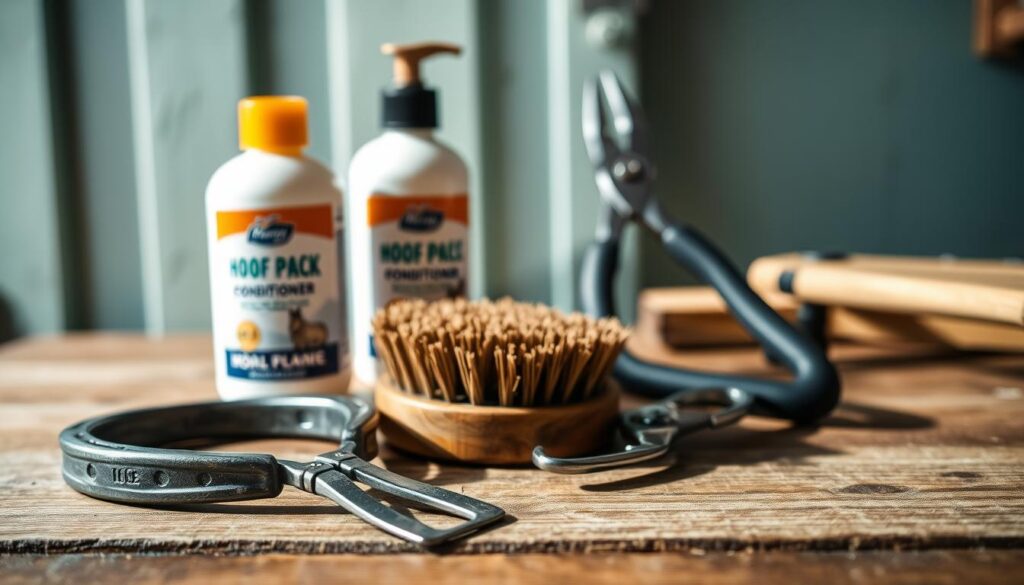Did you know that equines with structured daily schedules experience 40% fewer behavioral and digestive issues than those without? Consistency isn’t just comforting for humans—it’s a cornerstone of wellness for these majestic animals.
Establishing predictable patterns helps animals feel secure, whether they’re spirited youngsters or seasoned companions. Daily visual inspections—like checking hooves or coat condition—act as early warning systems for potential problems. Pairing this with scheduled feeding times and hydration monitoring creates a stable environment where they can thrive.
Youngsters, in particular, benefit from rhythm. Their growing bodies rely on balanced nutrition and regular exercise to develop properly. Even simple actions, like grooming sessions, strengthen bonds while promoting circulation and skin health.
An organized approach doesn’t just address immediate needs. It builds a framework for lifelong vitality, reducing stress-related ailments and fostering trust. After all, a happy animal isn’t just healthy—it’s engaged, calm, and ready to connect.
Key Takeaways
- Predictable schedules reduce stress and prevent common health issues.
- Daily visual checks catch problems early, saving time and resources.
- Young equines require tailored routines for optimal growth.
- Grooming strengthens human-animal bonds while boosting physical wellness.
- Consistent hydration and feeding times support digestive stability.
Understanding the Importance of Horse Routine Care
Imagine starting each day knowing your equine companion’s needs are fully met—no guesswork, just confidence. A structured schedule acts like a roadmap, guiding owners to make sure every critical task gets attention. From dental checks to hydration monitoring, consistency builds trust and keeps animals thriving.
Why does predictability matter? Animals flourish when they know what’s next. Scheduled dental care, for example, prevents painful issues like uneven wear or infections. Research shows regular checks reduce emergency vet visits by 35%. Pair this with daily grooming and feeding times, and you create a rhythm that supports both physical and mental wellness.
Owners who keep their equines on track also spot subtle changes faster. Is water intake dropping? Are hooves clean and balanced? These small observations, built into a routine, stop minor concerns from becoming crises. Plus, knowing you’ve covered all bases—from nutrition to parasite control—brings peace of mind.
Think of it this way: a well-planned schedule isn’t restrictive. It’s freedom. Freedom from worry, unexpected bills, and preventable health setbacks. By prioritizing daily structure, you’re not just maintaining an animal—you’re nurturing a partnership built on reliability and care.
Daily Horse Care Essentials
Morning sunlight filters through the barn windows as you begin the day’s most important task—ensuring your equine partner’s well-being. Consistent daily practices act as your first line of defense against health challenges while fostering trust and comfort.
Morning Health and Visual Checks
Start with a head-to-hoof inspection. Look for swelling, cuts, or unusual discharge. Check eyes for clarity and nostrils for clean airflow. Early detection matters—horses may hide discomfort until issues escalate. Note energy levels during this walk-around; sluggishness could signal dehydration or colic.
Hydration monitoring comes next. Refill troughs with fresh water, scrubbing them weekly to prevent algae. Pair this with veterinary care standards like checking manure consistency—a simple step that reveals digestive health.
Grooming, Feeding, and Water Management
Brush coats to remove dirt and distribute natural oils. Focus on sweat-prone areas like girth regions to prevent chafing. Use a curry comb in circular motions to boost circulation—this reduces stress while strengthening your bond.
Feed measured portions at fixed times to maintain metabolism. Incorporate parasite control additives if recommended by your vet. Always provide salt blocks to encourage drinking, especially during Canadian winters when water intake often drops.
Remember: even robust animals need daily attention. A horse healthy today could face hidden threats tomorrow. Through structured care and proactive veterinary care partnerships, you create lasting wellness one sunrise at a time.
Weekly Maintenance Tasks for a Healthy Horse
Weekly upkeep forms the backbone of equine wellness, transforming basic care into lasting protection. While daily attention addresses immediate needs, a seven-day cycle tackles hidden threats that accumulate over time.
Stall Cleaning and Manure Management
Ammonia fumes from urine-soaked bedding don’t just smell bad—they damage airways and soften hooves. A thorough stall cleanout each week removes waste buildup, cutting respiratory risks by 28% according to equine studies. Replace damp shavings and level flooring to support hoof care integrity.
Fence and Environment Inspections
Walk paddock perimeters looking for loose boards or protruding nails. Check gates for smooth operation and repair uneven ground that could twist joints. “A safe space prevents 90% of preventable injuries,” notes Ontario-based farrier Sarah Tremblay.
Daily grooming keeps coats shiny, but weekly tasks dig deeper. Brush tails thoroughly to remove debris, and inspect manure for signs of internal parasites like tapeworm segments. Catching these early means simpler treatments and healthier herds.
Finally, scrub water buckets and rotate grazing areas to disrupt parasite life cycles. These proactive steps create a fortress against threats—one sweep, one check, one clean stall at a time.
Monthly and Seasonal Routine Adjustments
As autumn leaves crunch underfoot, smart owners know it’s time to rethink their approach. Shifting weather patterns and daylight hours demand flexibility—what worked in July may falter by November. Proactive adjustments every few weeks keep animals thriving through frost, heat, or spring mud.

Adapting to Weather Changes
Winter’s bite means increasing hay rations by 15-20% to maintain body heat. Swap lightweight sheets for waterproof blankets when temperatures plummet below -10°C. In summer, provide shaded turnout areas and adjust exercise times to cooler mornings.
Shelter updates matter too. Clean fans before heatwaves hit, and check barn ventilation monthly. “A dry, draft-free space prevents 80% of seasonal respiratory issues,” advises Alberta equine specialist Dr. Liam O’Connor.
Scheduling Farrier Visits and Shoeing
Hooves grow faster in warm weather—schedule trims every 6-8 weeks. Ice-prone regions often benefit from winter traction shoes. Regular visits let professionals spot cracks or thrush early, saving months of recovery time.
Remember: consistency doesn’t mean rigidity. Tweaking routines as seasons shift shows attentiveness. Your four-legged partner relies on you to read nature’s cues—and act.
Routine Veterinary Exams and Health Monitoring
A yearly check-up might seem simple, but it’s your first defense against hidden health threats. Partnering with a trusted veterinarian creates a safety net, catching issues like lameness or weight fluctuations before they become emergencies. Studies show animals with regular exams require 30% fewer emergency treatments.
Vaccinations and Regular Check-ups
Core vaccines protect against deadly diseases like rabies and West Nile virus. Your vet will tailor schedules based on age, travel, and local risks—especially important in Canada’s diverse climates. Semi-annual visits allow professionals to listen for heart murmurs or assess joint flexibility.
| Vaccine | Frequency | Common Canadian Risks |
|---|---|---|
| Rabies | Annual | Wildlife exposure |
| West Nile | Spring booster | Mosquito-prone areas |
| Tetanus | Every 2-3 years | Soil-borne bacteria |
| Influenza | Semi-annual | Boarding facilities |
Establishing a Health Calendar
Mark deworming dates, dental floats, and vaccine reminders on a shared digital calendar. Apps like Equilab send alerts for upcoming vet appointments. Track weight trends and appetite changes monthly—a sudden drop could signal metabolic problems.
Consistency matters. When your veterinarian knows your partner’s history, they spot subtle changes faster. This teamwork slashes recovery times and keeps your four-legged friend performing at their peak.
Deworming and Parasite Control Strategies
Parasites lurk where you least expect—moist soil, shared troughs, even fresh hay. A customized prevention plan stops these silent invaders from compromising your animal’s vitality. Tailored programs consider local climate, herd dynamics, and seasonal risks to break parasite life cycles before they escalate.
Developing an Effective Deworming Schedule
Canadian winters freeze many parasites, but spring thaws revive threats. Work with your vet to match treatments to regional risks—like wet coastal areas needing extra lungworm vigilance. Rotate dewormers annually to prevent drug resistance. For example:
| Dewormer Type | Target Parasites | Best Use Timing | Common Canadian Regions |
|---|---|---|---|
| Ivermectin | Roundworms, bots | Late fall | Prairie provinces |
| Fenbendazole | Pinworms, tapeworms | Early spring | Maritime climates |
| Pyrantel | Strongyles, ascarids | Summer grazing | Central Ontario |
Monitoring Internal Parasites and Signs of Illness
Watch for subtle clues: weight loss despite good appetite, tail rubbing, or diarrhea. Fecal egg counts every 3-6 months reveal hidden infestations. “Blanket deworming wastes resources,” warns Manitoba vet Dr. Elise Girard. “Test-first approaches protect gut flora while targeting actual threats.”
Keep water sources clean—stagnant ponds host dangerous larvae. Pair this with hoof care routines to minimize thrush risks in muddy paddocks. Vaccines against diseases like West Nile virus also strengthen overall resistance to parasitic complications.
Remember: consistency beats intensity. Small, strategic actions—timed fecal tests, clean troughs, regional treatment plans—build an ironclad defense. Your vigilance today ensures thriving herds tomorrow.
Dental Care and Equine Dentistry Fundamentals
A gleaming smile isn’t just for show—it’s a window into your animal’s well-being. Proper oral maintenance ensures comfortable chewing and nutrient absorption, directly impacting digestive health. Without attention, minor issues escalate into weight loss or colic risks.
Regular Teeth Checks and Floating Procedures
Equine teeth grow continuously, creating sharp edges that irritate cheeks and tongues. Floating—filing these points—is done with specialized rasps under light sedation. Most animals need this every 6-12 months, depending on age and diet.
| Common Dental Issue | Visible Signs | Solution |
|---|---|---|
| Hooks | Head tossing while eating | Occlusal adjustment |
| Wave mouth | Uneven jaw movement | Balancing molars |
| Diastema | Food packing between teeth | Interdental cleaning |
Identifying Early Signs of Dental Problems
Watch for hay balls (“quidding”) dropped during meals—a red flag for pain. Bad breath or nasal discharge often signals infections. Saskatchewan vet Dr. Amy Leung notes: “Owners who notice slow chewing or weight changes catch 60% of issues before they become emergencies.”
Left untreated, dental imbalances strain jaw muscles and alter posture—sometimes affecting hooves through compensatory movements. Annual exams paired with attentive daily observation create a safety net for lifelong health.
Hoof Care Essentials for Longevity
What if a five-minute daily habit could add years to your animal’s active life? Healthy feet are the foundation of mobility, and attentive maintenance stops small issues from becoming career-ending problems. Consistency here isn’t optional—it’s the difference between a sprightly companion and one sidelined by preventable conditions.

Daily Hoof Picking and Inspection
Start by lifting each foot, using a hoof pick to clear debris from the sole and frog. Work from heel to toe, checking for lodged stones or packed manure. This simple act prevents thrush—a smelly bacterial infection thriving in damp Canadian winters.
Next, scan for cracks, heat, or unusual tenderness. Redness near the white line? That’s a warning sign. “Owners who spot bruises early avoid 70% of abscess cases,” shares British Columbia farrier Mark Desjardins. Schedule visits every 6-8 weeks for trimming, ensuring even weight distribution.
Weather plays a huge role. Muddy paddocks soften hooves, while dry summers increase cracking risks. Adjust cleaning frequency during seasonal shifts, and discuss protective sealants with your farrier.
Don’t forget: deworming supports feet health internally. Parasites like strongyles damage blood vessels in the lower limbs. Pair regular treatments with hoof care for 360° protection. Your vigilance today means joyful gallops tomorrow.
Grooming Techniques for Equine Well-Being
Picture this: a bonding ritual that doubles as a health check, transforming dust and sweat into gleaming vitality. Grooming isn’t just about aesthetics—it’s a frontline defense against environmental contaminants and a diagnostic tool rolled into one.
Brushing, Currying, and Skin Health
Start with a rubber curry comb in circular motions to loosen dirt and stimulate circulation. Follow with a stiff-bristled brush to whisk away debris, working in the direction of hair growth. Finish with a soft brush for that show-ready shine. This three-step process removes dead skin cells and reveals hidden issues like rashes or ticks.
| Tool | Purpose | Frequency |
|---|---|---|
| Curry Comb | Break up mud & exfoliate | Daily |
| Dandy Brush | Remove surface dirt | Post-exercise |
| Shedding Blade | Manage seasonal coats | Spring/Fall |
Effective management of grooming tools matters. Clean brushes weekly to prevent spreading bacteria. Store them in dry areas to avoid mold—a common issue in Canada’s humid summers.
Regular sessions reduce parasite risks by letting you spot lice eggs or ringworm early. “A thorough groom catches 50% of skin issues before they escalate,” notes Ontario equine specialist Marie-Claude Bélanger. Pair this with environmental controls like clean bedding to create a holistic defense system.
“Consistent grooming builds trust while serving as your animal’s first line of health monitoring.”
Keep sessions calm and predictable. Use long, steady strokes around sensitive areas like the flank. This approach minimizes stress while maximizing your ability to detect subtle changes in coat texture or body heat.
Feeding and Nutrition Management for Horses
Imagine transforming mealtime into a cornerstone of vitality with strategic feeding practices. Proper nutrition fuels everything from muscle development to immune function, making it as essential as vaccinations for long-term wellness. Start by offering 2-3% of body weight in hay daily—a golden rule that prevents overfeeding while meeting fiber needs.
Balancing Hay, Concentrates, and Supplements
Quality hay forms the foundation. Timothy or orchard grass suits most adults, while alfalfa provides extra protein for growing youngsters. Pair this with grain mixes or pellets tailored to activity levels—a barrel racer needs more energy than a retired trail companion.
Pasture access during the day offers natural exercise and fresh forage. Rotate grazing areas to prevent overgrazing and parasite buildup. “Animals with daily turnout digest food 25% more efficiently,” notes Manitoba equine nutritionist Dr. Raj Patel.
| Hay Type | Protein Content | Best For |
|---|---|---|
| Timothy | 7-11% | Adult maintenance |
| Alfalfa | 15-20% | Growing youngsters |
| Orchard Grass | 10-12% | Easy keepers |
Supplements fill gaps. Electrolytes support summer hydration, while omega-3s boost coat shine—making grooming sessions more effective. Always consult your vet before adding new products.
Remember: nutrition and vaccinations work together. A well-fed animal responds better to shots and recovers faster. Track weight weekly and adjust portions with seasonal changes—less grain in winter, more water in heatwaves.
Managing Shelter, Environment, and Social Needs
Ever wondered why some animals stay vibrant through Canada’s harshest winters? The secret lies in thoughtful shelter design and social bonds that keep spirits high. A well-planned environment does more than block wind—it fosters security, companionship, and lasting wellness.
Providing Adequate Shelter, Blanketing, and Turnout
Three-walled run-in sheds offer protection from snowdrifts while allowing free movement. Ensure ventilation prevents moisture buildup—a key factor in respiratory health. For winter turnout, waterproof blankets with 200-300g insulation suit most climates below -15°C.
Rotate pastures weekly to reduce mud and parasite hotspots. Pair this with daily manure removal—a simple step that cuts worm populations by 60%. Check shoes during turnout for secure fit, especially after ice storms when traction matters most.
| Temperature Range | Blanket Weight | Turnout Time |
|---|---|---|
| -20°C to -10°C | 300g | 2-4 hours |
| -10°C to 0°C | 200g | 4-6 hours |
| 0°C to +10°C | Light sheet | Full day |
Encouraging Social Interaction and Enrichment
Herd animals thrive with companionship. Pairing compatible buddies reduces stress-linked colic risks by 40%. Add boredom busters like hanging treat balls or obstacle courses—mental stimulation prevents destructive habits.
- Install slow-feed hay nets to mimic natural grazing
- Create dust-free rolling areas for skin care
- Schedule group turnout time during mild weather
Weekly shelter inspections catch hazards like loose boards or rusty nails near shoes. Set reminders to check blanket straps and repair worn areas promptly. Remember: a happy animal isn’t just sheltered—it’s engaged, connected, and thriving.
Preparing for Emergencies and First Aid in Horse Care
What if a split-second decision could save your animal’s life? Emergencies demand swift action and smart preparation. A structured program combines ready supplies with clear protocols to protect your partner when seconds count.
Essential Contents of a First Aid Kit
Stock these lifesavers in a waterproof container:
| Item | Purpose | Quantity |
|---|---|---|
| Antiseptic solution | Wound cleaning | 500ml |
| Self-adhesive bandages | Pressure application | 4 rolls |
| Digital thermometer | Fever detection | 1 |
| Sterile gauze pads | Bleeding control | 10-pack |
Include your vet’s contact info and a flashlight for night checks. Refresh expired items every 6 months.
Prompt Response to Injuries and Illnesses
Stay calm and assess body temperature first. Elevated readings (over 38.5°C) signal infection. Offer small sips of water while waiting for professional help—controlled feeding prevents choking during stress.
Isolate the animal in a clean stall to reduce risk of further injury. Document symptoms with photos and notes. “Quick thinking cuts recovery time by 50%,” emphasizes Alberta emergency vet Dr. Claire Dumont.
Integrate emergency drills into your program. Practice wrapping legs and taking vital signs monthly. Pair this with regular feeding schedule reviews—proper nutrition strengthens resilience during crises.
Conclusion
Caring for these majestic creatures demands more than passion—it requires a system built on consistency and expertise. Daily hoof checks, weekly deworming schedules, and seasonal shelter adjustments form layers of protection. Together, they create a safety net where animals thrive physically and emotionally.
From sunrise grooming to annual vet partnerships, every task—regardless of size—plays a role. Canadian owners know harsh winters and muddy springs test even robust systems. Yet, following expert recommendations transforms challenges into opportunities for growth.
Your efforts matter. A timely trim prevents lameness. Fresh water stops dehydration. Each choice ripples through your partner’s well-being. Start small: adopt one new practice this month, like fecal testing or rotational grazing.
Remember, you’re not alone. Collaborate with farriers and nutritionists to refine your approach. With dedication and smart planning, you’ll build resilience that lasts a lifetime—one thoughtful step at a time.

